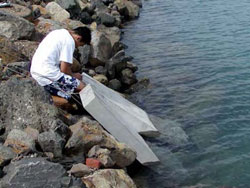Exceptional Performance
Chemical admixture provides long-term protection in a severe environment
It’s well known that chlorides can reach steel reinforcing bars through pores and hairline cracks in concrete, if resulting in extensive damage to reinforced concrete structures. To evaluate methods for reducing such effects, a long-term study of the durability of reinforced concrete specimens exposed to an aggressive marine environment was recently completed.
The study was initiated by Craig Newtson as part of a larger research project on durability of concrete made with Hawaiian aggregates. Twenty-five reinforced concrete test panels were exposed to warm salt waters in the tidal zone at Honolulu Harbor’s Pier 38 from 2002 to 2012.
 This study represents the longest continual test period ever carried out, worldwide, regarding the corrosion of reinforced concrete. Most of the test panels, including the control specimens, were produced using a low water-cement (ratio (w/c) of 0.40. Test panels were produced with various permeability-reducing and corrosion-inhibiting admixtures, with a latex modifier, or with pozzolans (fly ash or silica fume). The latter panels were produced using an even lower w/c of 0.36 to reduce the chloride penetration rates through the concrete and delay the onset of chloride-induced corrosion of the reinforcing steel. During the test period, half-cell potentials, chloride concentrations, cracking, and visible signs of corrosion were monitored.
This study represents the longest continual test period ever carried out, worldwide, regarding the corrosion of reinforced concrete. Most of the test panels, including the control specimens, were produced using a low water-cement (ratio (w/c) of 0.40. Test panels were produced with various permeability-reducing and corrosion-inhibiting admixtures, with a latex modifier, or with pozzolans (fly ash or silica fume). The latter panels were produced using an even lower w/c of 0.36 to reduce the chloride penetration rates through the concrete and delay the onset of chloride-induced corrosion of the reinforcing steel. During the test period, half-cell potentials, chloride concentrations, cracking, and visible signs of corrosion were monitored.
Key findings included:
- Control panels with no admixture or pozzolan exhibited corrosion-induced cracking and rust residue;
- While test panels produced using calcium nitrite—based corrosion inhibitors at dosages of 20 L/mi (4 gal/ydi) exhibited delayed onset of corrosion, test panels produced using 10 L/m3 (2 gal/yd3) dosages of the same admixture were not reliably protected against corrosion;
- The test panels produced using pozzolans (cement replacements of 15% fly ash or 5% silica fume) combined with a reduced uz/c of 0.36 performed well; and
- The panel produced using Kryton International’s Krystol Internal Membranem (KIM®) at a dosage of 2% by weight of cement was one of the top performing panels. The KIM panel outperformed all other permeability-reducing admixtures, and most of the corrosion—inhibiting admixtures as well. Only panels containing high levels of calcium nitrite and those made with pozzolans showed comparable performance. After 10 years of exposure, the KIM panel exhibited significantly lower half-cell readings than the control specimens. It also showed no signs of corrosion, even though panels produced with other admixtures or with a latex modifier exhibited inconsistent to poor results.
The panels produced using pozzolans or Kryton’s KIM performed well because they had lower permeability than the other panels in the study. Chloride ingress—even through hairline cracks—was slowed, so the onset of corrosion was significantly delayed. These findings are particularly relevant because they are based on field exposure in a harsh, coastal environment. While many products may perform well in a short-term laboratory experiment, their performance might be poor when subjected to long-term exposure to real environments
– Kryton International Inc., www.kryton.com
Jeff Bowman is Technical Manager at Kryton International Inc., headquartered in Vancouver, BC, Canada.
Source: Concrete International